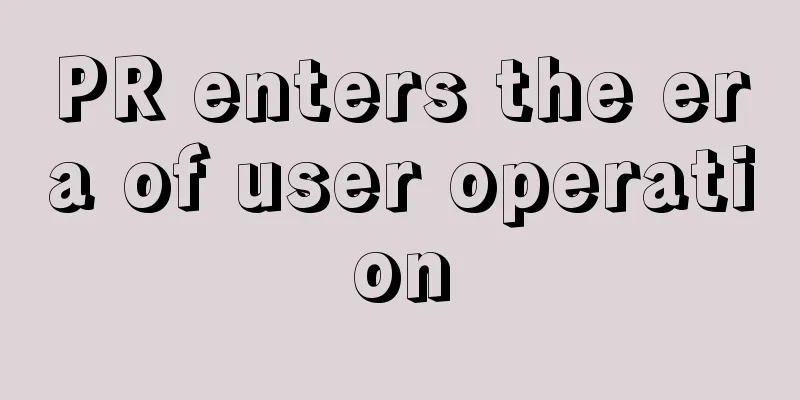Is it difficult to convert existing users into new ones at low cost?

In the era of internal circulation of existing users, is it difficult to activate dormant old users and convert them? Lack of traffic is a dilemma faced by both large and small companies. The key lies in how to quickly tap into the value of existing platform users and realize commercialization. Combining a sinking market project that I have operated before, I have made a transformation around the platform's stock, looked back at the project, and summarized a replicable methodology. Note: Part of the project data display When doing enterprise projects, the problems we face are complicated. Different industries and projects have different difficulties, and it is difficult to solve all problems with one method. If you insist on asking me to give an answer, the method I can think of is: system. Build a complete operation/marketing system, use the system and framework to limit the scope and reduce the probability of errors. A complete operation system, currently summarized, has 6 elements: operation, users, brand, people, goods, and venue. The core is the operation linking users and brands; the extension is to implement the implementation around people, goods, and venue.
1. In-depth operation, the core of stock conversionOperations are no longer just Internet operations. After 10 years of practical experience in marketing, my initial understanding of operations was more biased towards the Internet, where operations link users and products. However, as I worked on more and more projects, my understanding of the issues gradually deepened. If it is based on my own experience in traffic, products, private domains, content, and activity operations, and the operation links users and products, I think it is OK. If we go up a level and jump out of the scope of Internet operations, the operation needs to solve the relationship between users and brands. I have been in contact with some companies that are relatively new to Internet marketing. Operations not only need to achieve initial product growth and conversion, but also build brand value in the process. Strengthening the dissemination of brand value is more conducive to long-term user connections. If a project has a growth cycle, the cycle ranges from pioneering stage, breakthrough stage, growth stage, maturity stage to the final decline stage. In simpler terms, it can be divided into the "0-1" stage, the "1-10" stage and the "10-0" stage. The "0-1" stage is the early exploration of the project, which requires a deep understanding of the platform users and business. Find a unique solution for the project, explore the breakthrough point of the project, and run the project through. "0-1" is also the most difficult stage. "1-10" stage. The project has been successfully implemented and has entered a period of rapid growth. In addition to doing a good job on the current project, we must also be prepared for danger and plan the second growth curve in advance. Flowers do not bloom forever, and no one can guarantee that a project that runs smoothly will always be in a state of high growth. When the time is right, think a few more steps ahead. "10-0" stage. The project gradually enters the maturity and decline stage. The business begins to stabilize, and even the profit is decreasing. If the project conversion continues to have no growth, it is necessary to make timely adjustments to maintain stable cash flow, and the team's energy needs to be gradually transferred to new business. 2. Users, the operational basis for stock conversionHaving a user base is only the first step in conversion. Just like traffic is always only a part of business. Whether you focus on products to generate traffic or focus on traffic to generate products, the difficulty of subsequent conversion will be quite different. It is not ruled out that the free play method in the early days of the Internet was to attract free traffic and then gradually convert it through the "three-stage rocket". The most classic example is 360 Company, which used free anti-virus tools to attract users, then gradually upgraded to a safe network platform, and finally obtained the company's operating profit from advertising revenue from safe browsers and website navigation. Obviously, this model has many requirements. The free traffic-generating products here must be high enough and have sufficient brand potential. If you attract accurate target users around convertible products at the beginning, the more accurate the early users are, the deeper their understanding of the brand's value will be. The difficulty of conversion will be lower in the later stage, and it will be easier to establish a long-term relationship between users and brands. Take the sinking market project mentioned at the beginning of the article as an example. This company also made a typical mistake. The platform did not think clearly about how to build a "convertible product" system at the beginning. Although the platform’s core functional products have gained a lot of traffic, the conversion process has been lengthened invisibly. Because the traffic is general traffic, users’ understanding of the platform is focused on the use of tools, and it is more difficult to transform and convert in the later stage. The warning here is not to blindly pursue traffic. Before pursuing traffic, think clearly whether there is a matching "convertible product" system to undertake it. 3. Brand brings stock conversion one step closerMy understanding of brands is that brands allow users to instantly associate who you are and what you do. There are three core factors that influence users to place orders: demand, purchasing power and trust. The most difficult part of the problem that brands need to solve is trust. Imagine the process that users go through to understand you: recognition, cognition, approval, and subscription. When many unfamiliar brands are just born, they need to constantly make a presence in the market. Similar to planting grass on Xiaohongshu and dominating the screen with SEO soft articles, they constantly make a voice on the media platform that suits them, build momentum, and gain enough brand exposure. These preliminary work is to let more users know about this brand. When your brand has a deep enough impression in the minds of users, the next time someone needs something, how will he make a judgment if one brand is familiar to him and the other is unfamiliar to him? Having brand value can increase users' trust in the platform, which invisibly shortens the path to transaction conversion. Therefore, operations need to be carried out from a higher perspective. Building the brand value of the platform will bring conversion one step closer. 4. People: The First Factor in Stock OperationAny project cannot be separated from people. In addition to exploring the user dimension, people also include thinking at the platform organization level. Based on my limited experience, I have sorted out "people" from five perspectives. They are user insight, demand stratification, team management, department collaboration, and channel expansion. User insight and demand stratification are biased towards the user itself. Team management, department collaboration, and channel expansion are biased towards the organizational level. 1. User insights. The existing user base includes users and payers. It is necessary to correctly distinguish who are the real users. Dig deep into paying users, follow the 28 principles, and maximize the value of mining. Just like the "three-stage rocket" model mentioned earlier, the platform attracts a large number of non-target users and cannot generate real paid conversions. In the actual project, we must learn to distinguish who are the real valuable users. 2. Demand stratification. According to Maslow's need theory, users at different levels have different product demands. We should do a good job of level analysis of the platform's existing user base. We should also do more refined operations among the paying user base. For example, according to the purchasing power, some users will only choose relatively low-end products. After all, there are only a few users with high purchasing power, so we can provide higher-value VIP services. 3. Team management. "Select, train and retain" within the team to build a high-combat effectiveness team. To the upper level, give reasonable expectations and timely feedback on project results. Internally, improve professional skills and sort out and implement SOPs. 4. Departmental collaboration. Communicate and collaborate across teams to leverage resources to advance project implementation. Communicate and review in a timely manner to optimize project details and accelerate project iteration. 5. Channel development. Leverage external resources, connect with external cooperation, and efficiently promote project development. Select high-quality channel providers, find channels, screen channels, control channels, and optimize channels. Find channel providers with higher matching degree. 5. Goods, the basis for the transformation of inventory operationsWithout products to sell, conversion is like cooking without rice. A complete product system includes traffic-generating products, core products, profitable products, hot-selling products, and expansion products. Here, taking the retail industry as an example, each category of product concept is supplemented with explanations. 1. Use low-priced, just-needed or experience-oriented products to attract new users. For example, eggs, milk, and fruits in supermarkets are all good products that attract users’ attention. 2. Core products, advantageous products, high sales share, to ensure user repurchase. Fruits and vegetables, meat and poultry, aquatic products, etc. are important products in supermarkets and are also popular products in daily life. 3. Profitable goods, high gross profit goods, stable sales, average sales share. Many snack products have high profit margins, but their sales volume may not be the highest in supermarkets. 4. Popular products, which are products that spread word of mouth, have large short-term sales. Similar to seasonal fruits, such as selling watermelons in summer and chestnuts in winter. They have large short-term sales. 5. Expand products and extend products around core products to meet more user needs. Daily necessities in supermarkets belong to this category. The product classification here is relatively complete, but in actual project operation, the product system may not be so complete. I have come into contact with many projects, and the product line is very single, or even only one product is available for sale. Whether the product line is rich or single, you must have the awareness of sorting out the product line. Without product delivery, it is impossible to complete the user's value exchange. 6. Market: Conversion touchpoints for stock operationsThe market is the channel terminal for the transformation of existing operations. The most classic 4P theory in marketing. Product, pricing, promotion, channel. Whether I worked in traditional industries before or studied Internet marketing later, the 4P theory framework has always been the one I used the most. From the perspective of enterprise inventory management, the 4P theory is also an important theoretical framework. The value of the brand is transferred to the user. This is a transfer of energy. Products and prices belong to the energy of the brand. Any goods and services provided by the platform are potential energy transfers to users. On the other hand, how to link the value of the brand with users requires a transfer method and medium. Promotion and channels solve this problem. For existing users, APP, public account, mini program, etc. are very important channels. Event operation, content operation, and community operation are very effective operation methods. If there is no scene to reach users, that is, channel, the brand value and information cannot be accurately delivered to the user end. At a time when operations are becoming increasingly refined and homogenized, converting existing assets is no longer just a matter of breaking through at a single point. You need to learn to build a system and establish operational barriers. Author: Hu Xianwu; Official Account: Wenli Marketing Notes |
<<: Ten years of experience summary: 9 tips for international SaaS startups
>>: Traffic + old domestic products, can they really become popular again and again?
Recommend
How to set up Shopee live streaming? What is the method?
There are more and more newcomers doing live broad...
Measurement and attribution will be Netflix’s top priority for programmatic advertising
The following article will take a closer look at h...
It took me 14 years to figure out the core method of attracting customers! Share it for free and easily attract 100+ accurate customers a day
How can we achieve efficient traffic diversion? In...
Which logistics does shein platform use for delivery? How to choose?
The most important thing for everyone is the logis...
What does Lazada Flash Sale mean? Where is the registration entrance?
If you want to increase product sales and attract ...
2024 Spring Festival Homecoming, Xiaohongshu Sponsoring Spring Festival Gala, Competition in the Milk Tea Industry
The Spring Festival has passed. During your return...
Ele.me is stingy, Meituan is showing off its big factory, and MaruMei is advising to be conspicuous [Case Excavator]
This article writes about the wonderful case analy...
A must-read for local physical store owners: Using DeepSeek to disassemble and rewrite the copywriting of popular short videos
In the current fierce competition in the short vid...
How to return or exchange goods on Shopify? What are the rules?
When you shop online, if you are not satisfied wit...
What are the requirements for opening an Amazon business? Are the requirements high?
Some of the merchants who have opened stores on Am...
How do I move links to Lazada? Where can I set up logistics for Lazada?
For many new merchants, how to efficiently manage ...
How much does it cost to open a Shopee store? What are the fees?
Nowadays, everyone will choose the Shopee cross-bo...
I went to deliver food, let's see how much money I made
This article mainly shares the process and specifi...
HEYTEA x FENDI, another one-way collaboration?
The "HEYTEA" x "FENDI" collabo...
How is Suisse's cross-border e-commerce? When did it start?
Amazon is the largest cross-border e-commerce mark...









